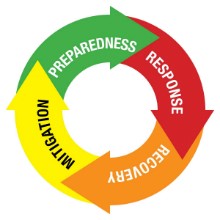Emergency Management Cycle
 An infographic on the emergency management cycle.
An infographic on the emergency management cycle.
Emergency management aims to reduce or avoid the potential losses from hazards, assure prompt and appropriate assistance to damaged materials, and achieve rapid and effective recovery. The emergency management cycle illustrates the ongoing process by which all organizations should plan for and reduce the impact of disasters, react during and immediately following a disaster, and take steps to recover after a disaster has occurred. As a cyclical process, it is never complete. Recovery, even from the smallest incidents, can inform prevention and mitigation.
• Mitigation: Activities designed to alleviate the effects of a major disaster/emergency or long-term activities minimizing the potentially adverse effects of future disaster in affected areas. It includes all actions to mitigate both hazards and vulnerabilities.
Examples: Keeping collections stored 4”-6” off of the floor on risers and/or shelves. Using earthquake straps to secure collections stored on shelves.
• Preparedness: Activities, programs, and systems that exist prior to an emergency and that are used to support and enhance response to an emergency or disaster. This phase implies that risks, hazards and vulnerabilities have been assessed.
Example: Having supplies and salvage equipment, like plastic sheeting and absorbent pads, stocked and placed near collections storage. Installing water sensors in areas that have had issues with leaks.
• Response: Activities and programs designed to address the immediate and short-term effects of the onset of an emergency or disaster such as artifacts salvage and relocation within 48 – 72 hours.
Examples: Draping shelves in plastic sheeting during a water emergency. Placing objects affected by mold in polyethylene bags to prevent cross-contamination.
• Recovery: Long-term activities and programs beyond the initial crisis period of an emergency or disaster designed to return all systems to normal status or to reconstitute these systems to a new, less vulnerable condition. Upon completion of the post-emergency critique, it is possible to update plans and implement corrective actions.
Example: Arranging for professional conservation treatments of damaged materials.